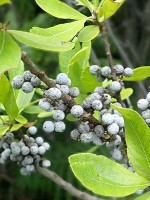Mon-Fri 9am - 5pm Mountain time
Black Raspberry vs Northern Bayberry
Rubus occidentalis
Myrica pensylvanica
NOT AVAILABLE THIS SEASON - MIGHT RETURN
The Black Raspberry is a multi-stemmed shrub that produces edible red berries that deepen to black as they mature. The berries are flavorful and are great for fresh eating and preserves. Black Raspberry shrubs bloom in late spring with white, rose-like flowers and attract many pollinators such as bees and butterflies.
Black Raspberries are floricanes primarily fruiting on second year canes. Each spring cut back all two-year old canes, leaving only the last year’s growth.
Northern Bayberry makes an excellent hedge or feature shrub. It will retain its leaves in warmer climates but drops them in colder areas. They produce blue-grey berries that have a wax coating on them that can be used to make candles or soaps.
In colder hardiness zones the leaves turn an attractive orange to red colour in the fall, making it a striking addition to your landscape.
Northern Bayberry is native to Nova Scotia and tolerates both drought and wet conditions. It is also a nitrogen fixer that tolerates poor soil conditions.
Black Raspberry Quick Facts
Northern Bayberry Quick Facts
Toxicity: Warning: The wax from bayberry fruit is considered toxic and may be carcinogenic.

